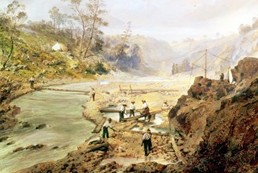TEXT:But still the people come.200 abandoned ships in San Francisco harbor , the crews deserting, rushing for the hills. He's traveled 6,000 miles. He's spent all his money. Now he travels by foot.Belgian Jean-Nicolas Perlot writes: We crossed 200 miles of wilderness full of Indians, bears, panthers, wildcats, snakes of every k ind. The first thing he finds isn't gold. It's graves. 200 of them. Prospectors cut off by rains in the foothills, starved to death. Approaching, we realized animals of some kind had dug up the bodies. I read a note attached to one of the graves. "God has willed that civilization should begin in this place, With this duty which a man owes to his kind. Bury the dead." Perlot does find gold, but never in the quantities that he'd dreamed. As the gold fields are picked clean, tensions rise, times get tougher. After just five years, the Gold Rush is over. I think that there is that Western mentality of prospecting --try and fail, try and fail, and the fact that you tried is worthy in and of itself. Of 300,000 who rush to find gold, less than one out of 100 struc k it rich. But fortunes were made by the merchants and landowners who supplied the miners. From dirt and dreams came the great cities of California. Both the West and the American character that built it are settled. Now this new powerhouse will face another revolution.
译文:但淘金者仍纷至沓来。有200艘船只被遗弃在了旧金山港,弃船人员向山区匆匆进发。他一路航行了6000英里,花光了身上的所有钱财,现在徒步跋涉。比利时人让·尼古拉斯·佩尔罗写道:我们穿越了200英里的荒野,到处都有印第安人、熊、豹、野猫和各种蛇出没。他首先找到的并非期待中的黄金,而是坟头,足足有200座。淘金者们在山脚陷入大雨围困,结果活活饿死。走近了,我们才发觉不知道是些什么动物把坟墓刨开了,我看到一座坟头上留有张字条,上帝的旨意要让此地成为文明的滥觞,创造文明是人对其同类的必履之责,请将死者安葬。佩尔罗找到了金子,但没有他期望的那么多。当金矿几近枯竭时,人际关系陡然恶化,生计变得更难维持,淘金热仅仅持续了五年便偃旗息鼓。吉米·威尔士[维基百科创始人之一]:“我觉得淘金热体现了一种西拓精神,屡试屡败,屡败屡试,尝试本身就是价值所在。”在30万之众的淘金队伍中,能发家致富的还不到百分之一,真正发财的是为矿工提供生活设施和补给的商人和地主。脱胎于泥土,起源于梦想,一座座伟大的城市在加州拔地而起,西部定居点确立的同时,成就这一切的美国精神也随之确立。这个新兴的强大国家将面临另一场革命。













